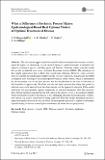What a difference a stochastic process makes : epidemiological-based real options models of optimal treatment of disease
Abstract
The real options approach has been used within environmental economics to investigate the impact of uncertainty on the optimal timing of control measures to minimise the impacts of invasive species, including pests and diseases. Previous studies typically model the growth in infected area using geometric Brownian motion (GBM). The advantage of this simple approach is that it allows for closed form solutions. However, such a process does not capture the mechanisms underlying the spread of infection. In particular the GBM assumption does not respect the natural upper boundary of the system, which is determined by the maximum size of the host species, nor the deceleration in the rate of infection as this boundary is approached. We show how the stochastic process describing the growth in infected area can be derived from the characteristics of the spread of infection. If the model used does not appropriately capture uncertainty in infection dynamics, then the excessive delay before treatment implies that the full value of the option to treat is not realised. Indeed, when uncertainty is high or the disease is fast spreading, ignoring the mechanisms of infection spread can lead to control never being deployed. Thus the results presented here have important implications for the way in which the real options approach is applied to determine optimal timing of disease control given uncertainty in future disease progression.
Citation
Dangerfield , C E , Whalley , A E , Hanley , N & Gilligan , C A 2018 , ' What a difference a stochastic process makes : epidemiological-based real options models of optimal treatment of disease ' , Environmental and Resource Economics , vol. 70 , no. 3 , pp. 691-711 . https://doi.org/10.1007/s10640-017-0168-x
Publication
Environmental and Resource Economics
Status
Peer reviewed
ISSN
0924-6460Type
Journal article
Description
This work is funded jointly by a Grant from BBSRC (Grant No. BB/L012561/), Defra, ESRC, the Forestry Commission, NERC and the Scottish Government, under the Tree Health and Plant Biosecurity Initiative.Collections
Items in the St Andrews Research Repository are protected by copyright, with all rights reserved, unless otherwise indicated.

